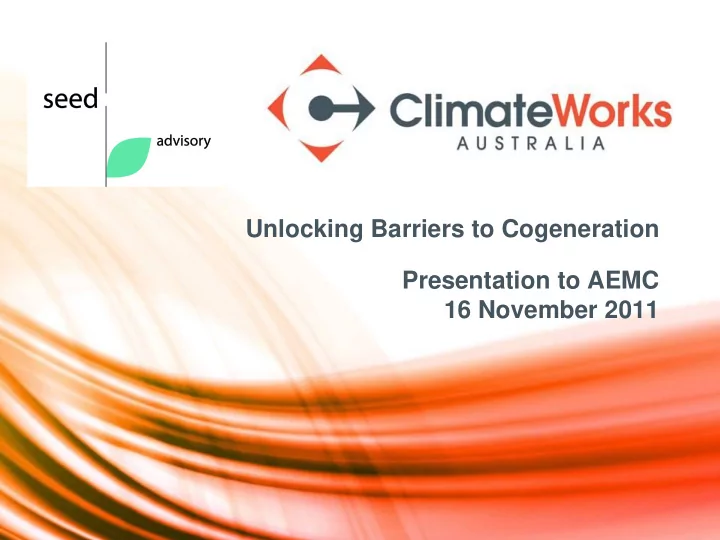

Unlocking Barriers to Cogeneration Presentation to AEMC 16 November 2011
About ClimateWorks Australia ClimateWorks Australia is a non-profit organisation created in 2009 by The Myer Foundation & Monash University, focused on enabling practical projects to deliver emissions reductions in Australia. About Seed Advisory Seed Advisory is a commercial advisory firm specialising in the energy sector, with expertise in strategy, risk management, policy development and commercial management. 1
The problem? Barriers in the connection process Costs of connection process Case-by-case approach; each Delays in process distributor follows a different Can be up to a year for connection process; not many are small projects and 2.5 published years for large projects Lack of transparency in Commercial building information required developments require Misaligned decision-point timeframe of 1-3 months, milestones between electricity with 6 months max network owner and commercial Technical network studies and cogen project owner potential equipment upgrades Uncertain timeframes Costs of anticipating and then Lack of common contract terms reworking designs District-level projects face further Potential redesign after distributor barriers to connect multiple sites requirements received later in process, possibly lowering 2 performance and efficiency
This project set out to design solutions that could be implemented in the short term, based on real commercial project experiences Collaborative, commercially-based approach: six ‘live’ commercial projects as case studies: commercial scale cogeneration plants that would otherwise be ready to ready to commence within one year, but for barriers working group that includes customers, market participants, regulators, operators and policymakers Aim: Design a solution that is relevant to all in the portfolio, moving beyond one-off approaches to a standardised approach Start with cogeneration ‘cogeneration’ includes tri -generation potential to extend to renewable embedded generation as many of the issues are common 3
Participatory format brought together ‘live’ cogeneration projects with distribution businesses and government Organisation Role Colonial First State Management Services Case Study owner – CBD office building Crown Melbourne Case Study owner – CBD casino hotel & retail site Leighton Properties and the APN Group Case Study owner – CBD office building Monash University Case Study owner – University faculty building Moreland Energy Foundation Case Study owner – community centre site VicUrban Case Study owner – greenfield development site Aurecon Cogeneration engineering consultant Cogent Energy Cogneration plant provider CitiPower Electricity distributor United Energy Electricity distributor Origin Energy Electricity retailer Property Council of Australia – Vic Division Property industry advocate Australian Energy Market Operator (AEMO) Government agency – manager of the NEM Government agency – regulates the wholesale Australian Energy Regulator (AER) energy market and transmission & distribution networks in the NEM Victorian Department of Business & Innovation State Government Department Victorian Department of Primary Industries State Government Department 4 Sustainability Victoria State Government agency
Issues covered streamlining the process of connection is the short-term priority improving the economics is a longer term issue timeframes, common contract terms, improved interaction with distributors earlier in the project design and connection application process mindful of the previous work that has been done rule change proposal building on existing National Electricity Market framework in Chapter 5, and the new Chapter 5A engaging with current market consultations to ensure consistency with proposed rule changes and use existing channels to implement remaining solutions 5
Proposal 1 – standardising the connection process (Rule Change) Extend automatic right to connection to cogen (similar to rooftop solar PV) standard fee, time and terms for projects meeting automatic standards Allow DNSPs to be paid a fee-for-service to engage with designs earlier to help avoid information imbalance and prevent later redesign work Require DNSPs to publish annual ‘exceptions’ reports on network constraints to help eliminate surprises in network connection costs How? via Rule Change to Chapter 5 Connection Connection Connection Agreement Application Enquiry Offer Site satisfies Confirmed in 20 May invite DNSP Automatic automatic days for to advise in Access standards (to standard fee design phase be defined) and terms Proceeds under 65 days, with May invite DNSP Negotiated specified opt-in to advise in Access timeframe in standard design phase amended Ch 5 contract terms 6
Proposal 2 – multi-site connections (AEMO and AER discussions) Allow ‘subtractive metering’ to enable owners with contiguous sites to ‘net off’ production against consumption across all sites before payment to market ensures related party sites can be treated as if one site How? via AEMO discussions re demand side aggregation Allow multi- site developments to become ‘registrable exempt networks’ removes uncertainty around individual exemptions How? via AER consultation on network service provider exemptions Customer Customer Cogen or Cogen or DNSP TNSP Generator DNSP TNSP Generator Trigen Trigen Customer Energy flows National Customer Handover points at the meter electricity market 7
Next steps Share the findings nationally, before submitting National Electricity Market rule change to Chapters 5 Encouraging a broad coalition in favour of the proposed changes and prepared to advocate on their behalf Respond to formal rule change process two rounds of consultation by AEMC over approx 12-18 months Make submissions to upcoming reviews (eg AER) Continue working group discussions to maintain industry input focus areas include policy advocacy, technical standards, tool kits 8
THANK YOU Report is available at: www.climateworksaustralia.org
Recommend
More recommend